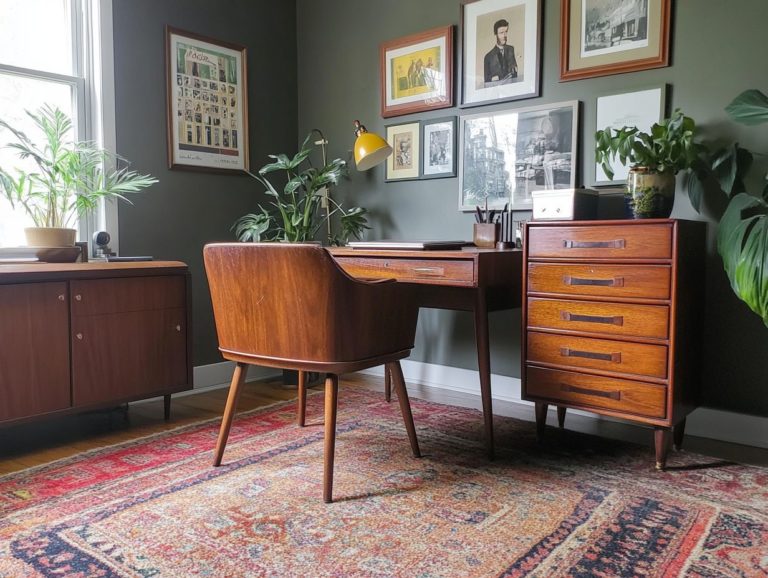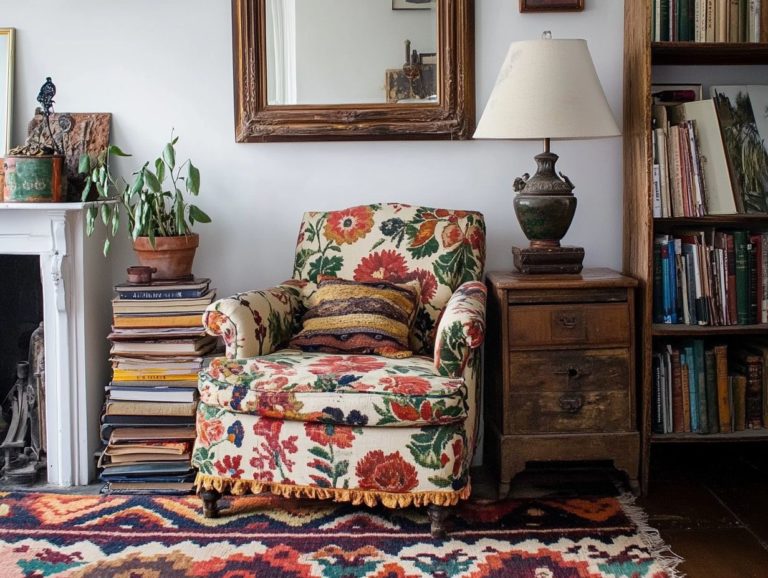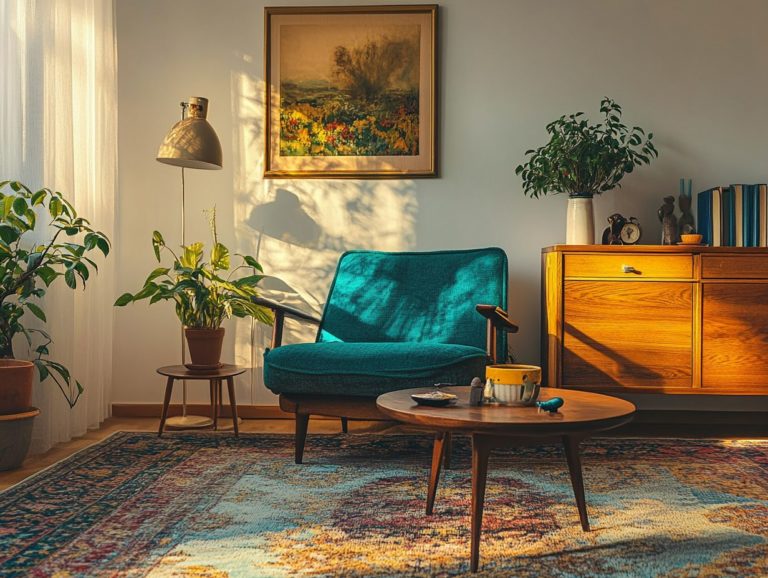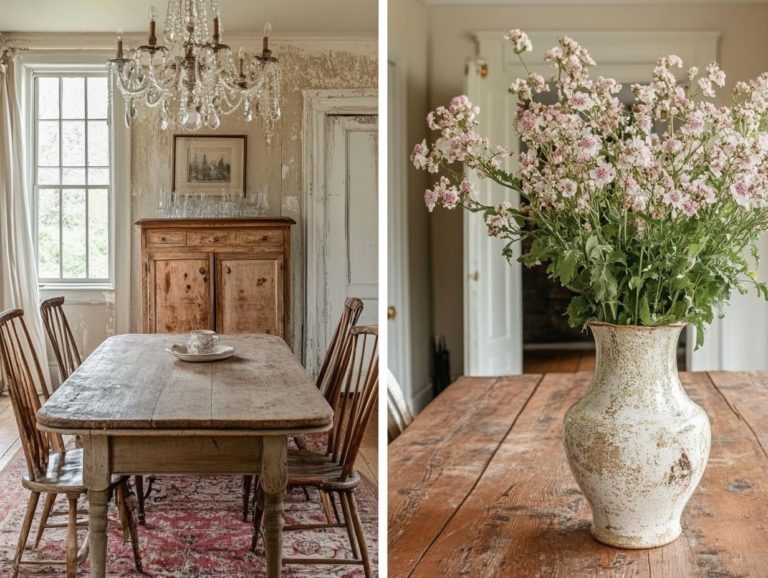Exploring Vintage Furniture Maker Signatures
Vintage furniture maker signatures serve as more than mere names; they are essential clues that unveil the narrative of craftsmanship, quality, and the rich history behind each piece.
This article delves into the importance of these signatures, guiding you on how to identify them and master the art of valuing vintage furniture. It also shines a spotlight on renowned makers and their distinctive styles, providing you with practical tips on preservation and display.
Whether you re a seasoned collector or an intrigued novice, you ll find valuable insights tailored just for you.
Contents
- Key Takeaways:
- Identifying Vintage Furniture Maker Signatures
- Famous Vintage Furniture Makers and Their Signatures
- Key Makers and Their Signature Styles
- Collecting and Valuing Vintage Furniture with Signatures
- Preserving and Displaying Vintage Furniture with Signatures
- Frequently Asked Questions
- What is considered a vintage furniture maker signature?
- Why are vintage furniture maker signatures important?
- How can I start exploring vintage furniture maker signatures?
- What are some common types of vintage furniture maker signatures?
- How can I verify the authenticity of a vintage furniture maker signature?
- Are vintage furniture maker signatures always accurate?
Key Takeaways:
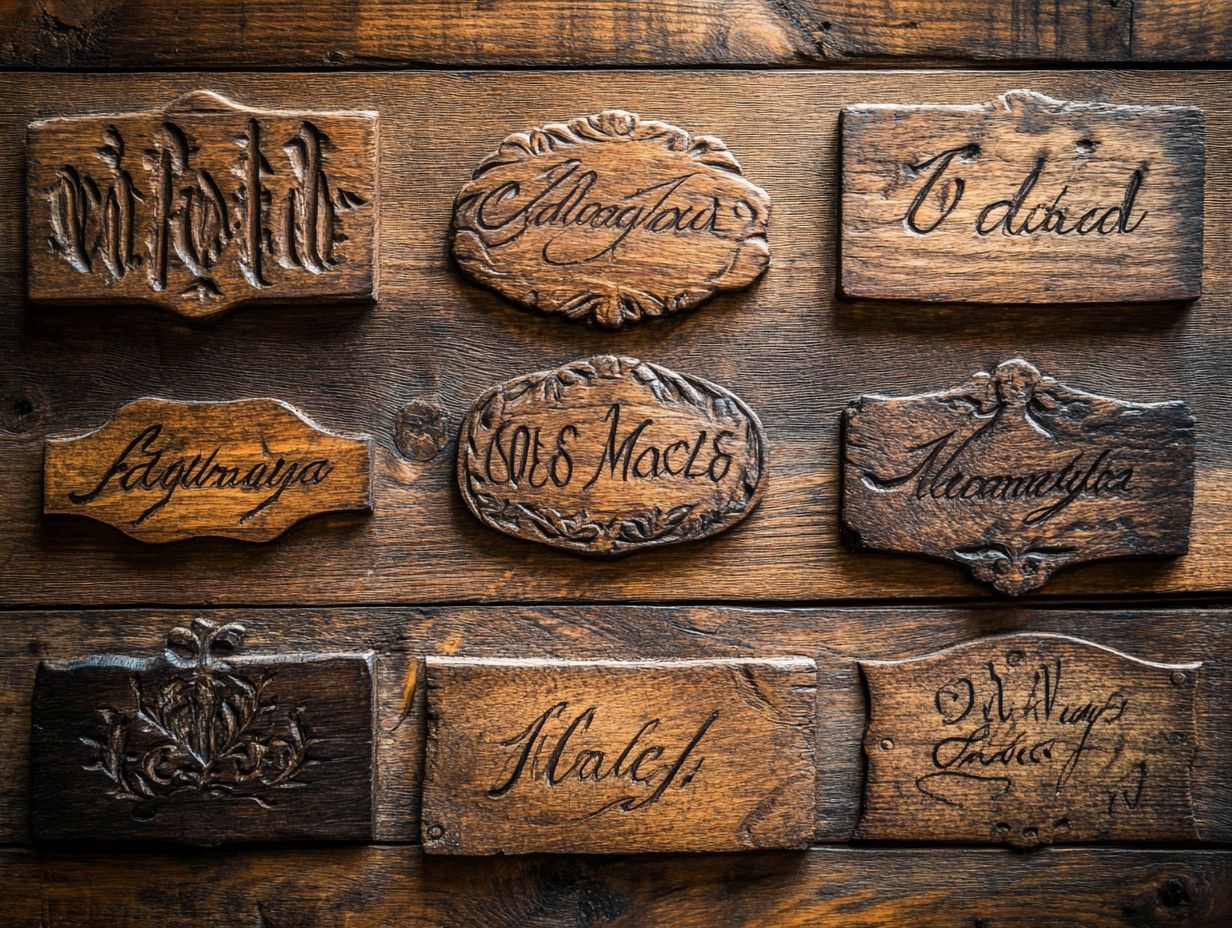
- Vintage furniture maker signatures can provide valuable information about the piece and its history.
- Identifying signatures can be done by examining common locations and styles, as well as using specialized tools and techniques.
- Famous vintage furniture makers and their signatures can greatly influence the value of a piece.
- Collectors should consider factors such as rarity and condition when valuing and collecting vintage furniture with signatures.
- Proper maintenance and care are essential for preserving the authenticity and value of vintage furniture with signatures.
- Displaying vintage furniture with signatures can be done creatively, such as incorporating them into a gallery wall or using them as statement pieces.
What are Vintage Furniture Maker Signatures?
Vintage furniture maker signatures, often known as maker s marks, serve as distinctive emblems or inscriptions on wooden furniture, signifying the creator s identity and the quality of their craftsmanship. When you encounter these identifying marks, they can offer invaluable insights into the furniture’s history, styles, and authenticity. This makes them essential for collectors and enthusiasts like yourself.
Grasping these signatures can unlock a treasure trove of insights for you! They significantly impact the perceived value and historical significance of a piece.
These signatures have roots in various historical contexts, often reflecting artistic movements and regional craftsmanship trends of their time. For example, during the Arts and Crafts movement, a design movement focused on handmade craftsmanship from the late 19th to early 20th centuries, specific maker’s marks became synonymous with quality and artisanal techniques, enhancing the allure of the furniture. You can learn more about this in our guide on exploring vintage furniture style icons.
Different styles, whether mid-century modern or Victorian, exhibit unique signatures that embody the aesthetic principles of their respective eras.
The variety of these marks, ranging from handwritten initials to intricate logos, showcases the maker s commitment to their craft. This helps you discern authentic pieces from mere reproductions.
Ultimately, a vintage furniture maker’s signature not only identifies the creator but also resonates with the rich narrative behind each piece, inviting you to delve deeper into how to identify authentic vintage furniture and its story.
Why are They Important?
Understanding the significance of vintage furniture maker signatures is essential for you as a collector or enthusiast. These signatures not only authenticate a piece but also play a pivotal role in determining its market value, which refers to the price a piece could fetch in the marketplace.
They serve as a historical bridge to renowned manufacturers like Basic-Witz Furniture Industries and Stanley Furniture, revealing craftsmanship techniques and styles from various periods, including the Federal and Victorian eras.
These distinctive marks offer valuable insights into a piece’s history, enriching the story behind each item and heightening its appeal among collectors. For those immersed in the world of antique collecting, recognizing these signatures can be the key to acquiring a highly coveted treasure instead of a mere imitation that lacks historical significance.
Market trends are often influenced by the recognition of these signatures, impacting furniture values and guiding appraisers in their assessments. Researchers also leverage maker signatures to explore regional styles and practices, deepening the narrative of American furniture history and fostering a greater appreciation for craftsmanship.
Now is the perfect time to explore vintage furniture to discover hidden gems before they re gone!
Identifying Vintage Furniture Maker Signatures
Identifying the signatures of vintage furniture makers requires careful observation and a solid grasp of the diverse styles and characteristics that have emerged throughout various furniture periods.
By closely examining specific identifying marks, you can trace the lineage of your pieces back to esteemed manufacturers such as Lane Furniture, Mengel Furniture, and Goodwood. Additionally, discovering the top vintage furniture brands can offer you a deeper understanding of the craftsmanship quality while revealing the aesthetic nuances that define the era in which they were created.
Common Locations and Styles
Common spots where you ll find vintage furniture maker signatures include the underside of tabletops, the backs of chairs, or tucked away in drawers. These signatures often come with decorative flourishes that echo the specific styles and aesthetics of the furniture.
Not only do these locations serve as practical identification points, but they also elevate the overall design and craftsmanship of the piece, beautifully merging functionality with art. You can often trace such signatures back to esteemed furniture-making regions like New England or the Midwestern states, each showcasing distinct styles such as Shaker, Arts and Crafts, or Federal. For those interested in enhancing their home with unique pieces, finding vintage furniture with character can be a rewarding experience.
In these regions, unique labels or tags reveal not just the maker’s name but also provide insights into the piece s history and intricate details. Antique designs frequently feature ornate carvings, inlays, or finishes specific to their origins.
Meanwhile, modern tags might display QR codes (scannable codes that link to digital information) or authenticity symbols, linking back to their rich heritage and craftsmanship. This captivating blend of identity and artistry truly emphasizes the value of each piece, enhancing the allure of vintage furniture.
Tools and Techniques for Identification
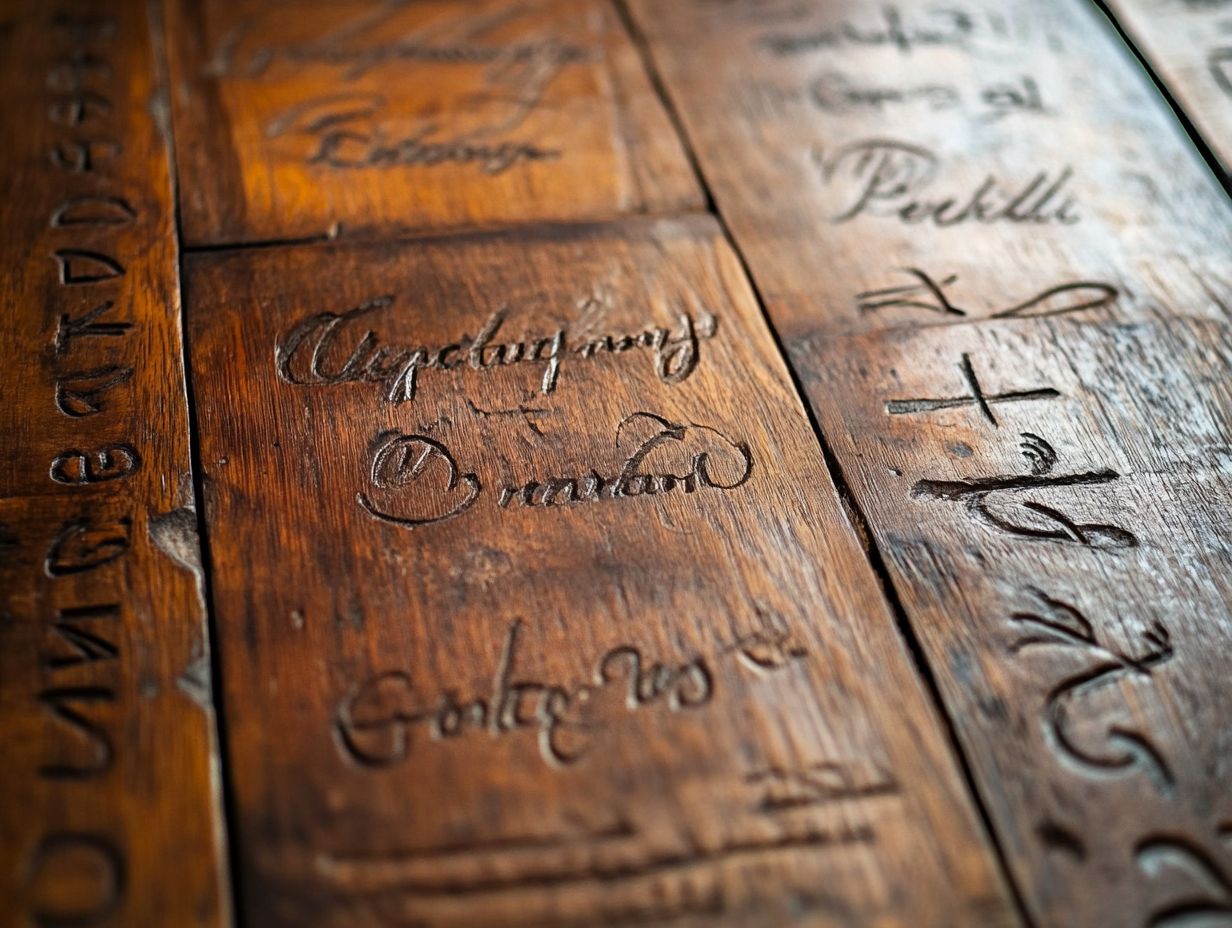
Effective identification of vintage furniture maker signatures calls for a blend of tools and techniques. You’ll want to have a magnifying glass handy for those close inspections, along with a solid familiarity with historical catalogs that highlight various maker’s marks and craftsmanship styles.
By utilizing these resources, you can significantly enhance your ability to accurately assess and restore vintage pieces, ensuring that authenticity and value remain intact. You might also find that specialized lighting and digital imaging tools are invaluable for revealing intricate details that aren’t immediately visible.
When inspecting furniture, delve into a thorough analysis of construction methods, like dovetail joints (a type of joint used to connect wood pieces securely) and wood types, as these elements provide vital context about the era and the maker. For a deeper understanding, consider uncovering the secrets of vintage furniture frame styles.
Restoring your pieces thoughtfully not only keeps them looking beautiful but also connects you more deeply with their history. By employing these meticulous methods, you cultivate a greater appreciation for the artistry that lies behind every vintage treasure.
Famous Vintage Furniture Makers and Their Signatures
Throughout history, you’ve likely come across numerous furniture manufacturers that have earned praise for their exceptional craftsmanship and signature styles. Their pieces are highly sought after by collectors and enthusiasts.
Notable names like Harmony House, R-Way, and Lane Furniture have established a legacy that resonates in their furniture models and distinctive maker s marks. These marks not only offer a glimpse into the quality of craftsmanship but also reflect the aesthetics that defined their respective eras.
Start your vintage furniture adventure today and uncover the stories behind each piece!
Key Makers and Their Signature Styles
Key players in the vintage furniture realm possess signature styles that set their pieces apart, significantly impacting the overall collectors’ market. Consider the elegant lines of Queen Anne furniture and the intricate motifs of Louis XIV; both are instantly recognizable and admired for their exceptional craftsmanship and distinct characteristics.
Then there s Charles Rohlfs, celebrated for his bold designs and artisanal woodwork that highlight the beauty of natural materials.
His creations radiate a rustic yet refined charm that stands out in any collection.
And let s not forget the mid-century modern icons like Hans Wegner and Eero Saarinen. Their streamlined aesthetics continue to captivate collectors, thanks to their timeless appeal and functional forms.
These stylistic innovations not only define the eras they represent but also set trends in antique collecting. They inspire modern designers who are eager to weave vintage elements into contemporary interiors.
Collectors often forge an emotional connection with these historic pieces, which only enhances their inherent value in the marketplace.
Collecting and Valuing Vintage Furniture with Signatures
Collecting vintage furniture with verified signatures is not just a captivating hobby; it s an exciting investment opportunity you don t want to miss! The presence of these signatures often correlates directly with the intrinsic value of the pieces.
For you as a furniture collector, learning how to appraise furniture and dating techniques can elevate the quality of your collection.
Understanding the unique history and authenticity of each piece is essential.
Tips for Collectors
For collectors seeking to elevate their vintage furniture collection, conducting thorough research is essential. Familiarizing yourself with furniture catalogs and performing checks to ensure the piece is genuine will set a strong foundation.
Understanding the intricacies of antique collecting will enable you to make informed decisions when acquiring valuable pieces.
By diving into reputable resources and catalogs, you can significantly enhance your knowledge of various styles and periods. This will help you hone your ability to differentiate between authentic signatures and clever reproductions.
Cross-referencing your findings with databases dedicated to furniture makers is crucial, as these platforms often provide detailed histories and characteristics of marked pieces.
Engaging with collector groups or forums offers valuable insights and advice, ensuring that your approach to building a credible collection is well-rounded. Don t wait! Start your collection today!
Factors that Affect Value
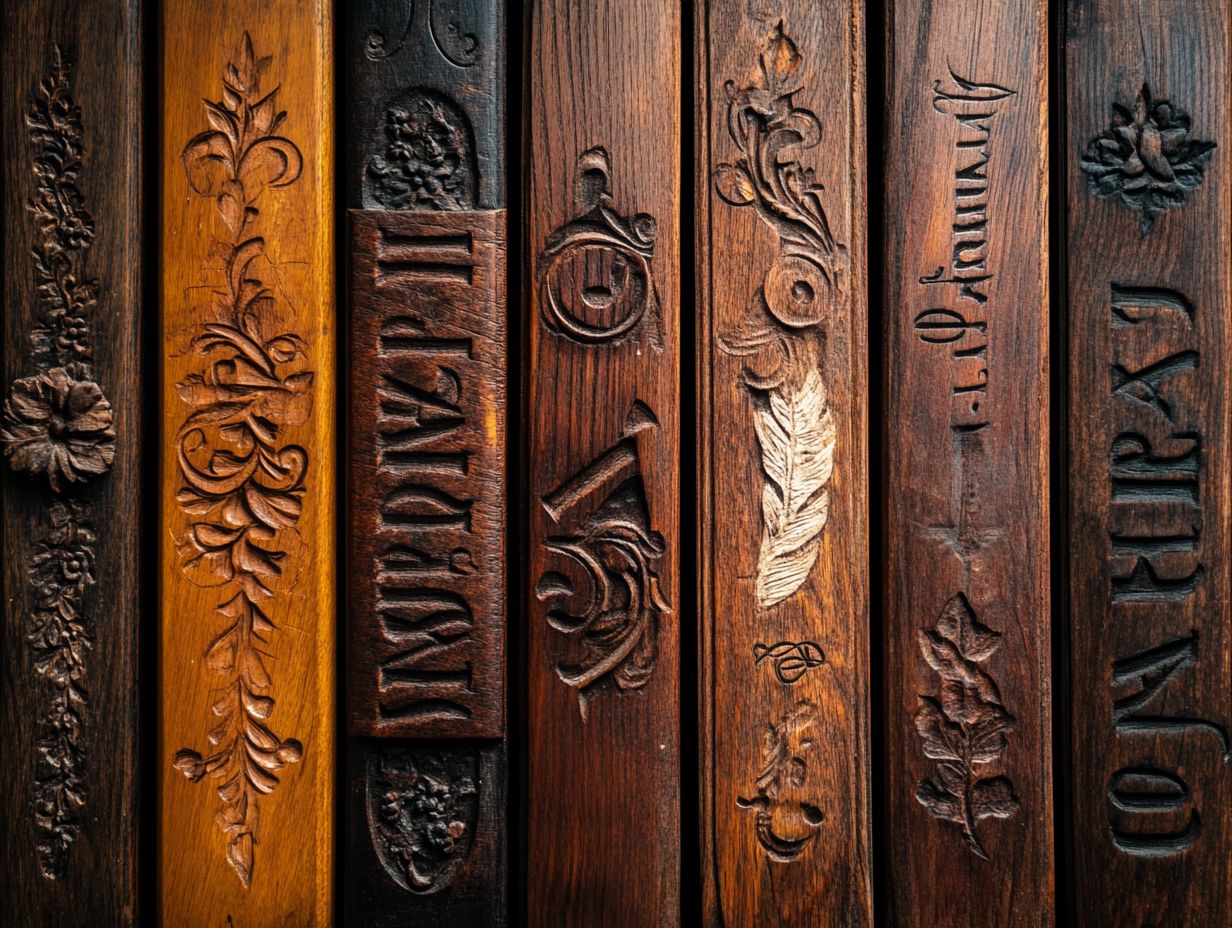
Several factors influence the value of vintage furniture, including the quality of craftsmanship, the authenticity of maker signatures, and the evolution of furniture styles over time. By understanding these elements, you can make more informed purchasing decisions and appreciate the intrinsic worth of your pieces.
The intricate craftsmanship inherent in each item often serves as a testament to its era, reflecting not just the aesthetic standards but also the cultural values of the time.
Authenticity is equally paramount; pieces that still bear their original maker s signature tend to command higher prices, thanks to their verified lineage.
As furniture styles evolve, certain designs become particularly coveted, resulting in fluctuations in collectible value. It s essential for collectors like you to stay attuned to these trends, as shifts in taste can significantly impact which pieces are deemed desirable over the years.
Preserving and Displaying Vintage Furniture with Signatures
Preserving and displaying vintage furniture with signatures demands your careful attention to maintenance practices and aesthetic considerations that truly honor the antique designs and craftsmanship of each piece.
Implementing effective preservation strategies will not only prolong the lifespan of your treasured items but also elevate their visual appeal, ensuring that the maker’s marks are showcased prominently for all to admire.
Proper Maintenance and Care
Proper maintenance and care of your vintage furniture are crucial for preserving both its aesthetics and craftsmanship. This ensures that maker signatures remain intact and visible. By committing to regular cleaning, environmental control, and careful handling, you can significantly extend the life of these treasured pieces.
In terms of cleaning, opt for gentle techniques using non-abrasive cloths and natural solutions like vinegar or olive oil. These methods effectively remove dust and grime without harming delicate finishes. To prevent warping and cracking, maintain a stable environment by regulating humidity and temperature.
Approach restoration thoughtfully, using materials that match the original finishes. This keeps the charm and history of your piece alive and thriving. It s also wise to keep a record of any restoration work done, as this not only protects the vintage item’s value but also serves as a testament to its storied past.
Creative Ways to Showcase Signatures
Showcasing vintage furniture signatures creatively not only elevates the aesthetic appeal of your home but also pays tribute to the craftsmanship and history behind each piece. Innovative display solutions, like shadow boxes or themed arrangements, allow you to highlight these maker s marks while seamlessly integrating them into your vintage decor.
Incorporating antique design elements, such as ornate frames or distressed wood backdrops, creates a cohesive visual narrative that accentuates the heritage of each item. A curated gallery wall featuring these signatures alongside historical photographs or personal mementos presents a unique storytelling opportunity that invites conversation and engagement.
Using elegant lighting to enhance the details of each signature casts a warm glow, adding depth and richness to your decor. Additionally, mixing modern accessories with these vintage treasures creates a refreshing contrast, celebrating the timeless charm of furniture history while resonating with contemporary tastes.
Frequently Asked Questions
What is considered a vintage furniture maker signature?

A vintage furniture maker signature is a distinct mark or label that identifies the maker of a piece of furniture from a particular time period. This can include engraved or stamped initials, names, or logos.
Why are vintage furniture maker signatures important?
Vintage furniture maker signatures are important because they provide valuable information about the history and authenticity of a piece of furniture. They can also help identify the style and origin of the furniture.
How can I start exploring vintage furniture maker signatures?
You can start exploring vintage furniture maker signatures by researching well-known furniture makers from the time period or region you are interested in. You can also visit antique shops or online marketplaces to examine different signatures in person.
What are some common types of vintage furniture maker signatures?
Some common types of vintage furniture maker signatures include handwritten signatures, engraved or stamped initials, and paper labels. These can be found on different parts of the furniture, such as the back, underside, or drawers.
How can I verify the authenticity of a vintage furniture maker signature?
The best way to verify the authenticity of a vintage furniture maker signature is to consult with an expert or conduct further research. You can also compare the signature with known examples or reach out to the manufacturer directly.
Are vintage furniture maker signatures always accurate?
No, vintage furniture maker signatures may not always be accurate. Keep in mind that some makers may have used multiple signatures or may have been imitated by others. Additionally, signatures can fade or be removed over time, so they should not be the only factor in determining authenticity.


